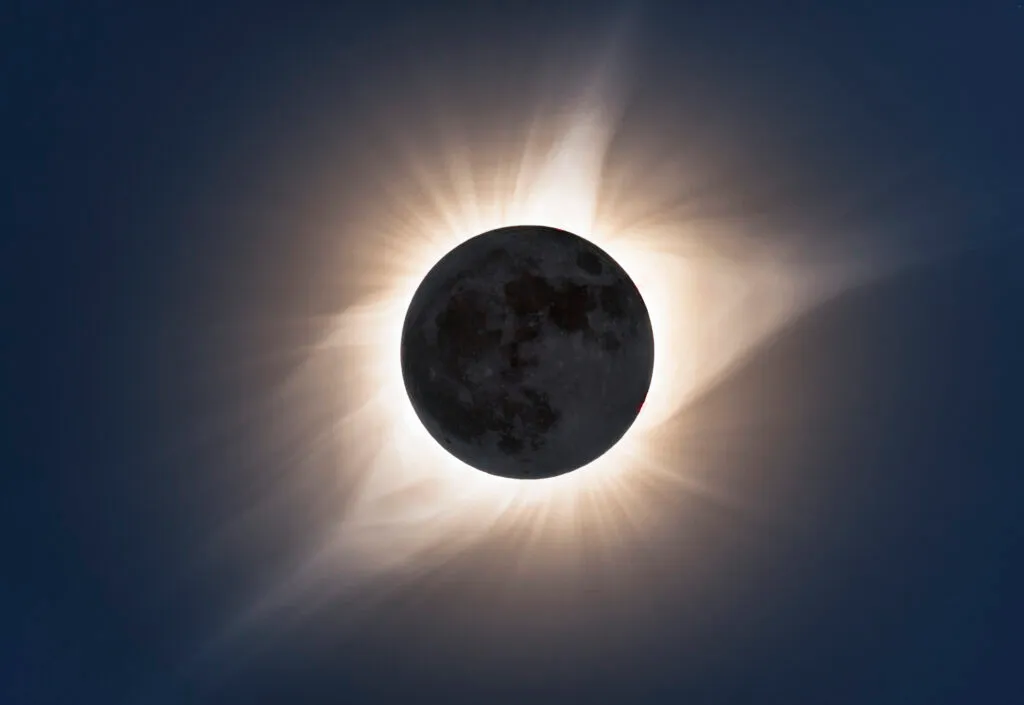Prepare for a breathtaking cosmic display that is sure to astonish the United States.
Mark your calendars for April 8, 2024, when a complete solar eclipse is poised to adorn the heavens. During this extraordinary occurrence, the Moon will align to obscure the Sun, casting its shadow across Mexico, the United States, and Canada, presenting a mesmerizing spectacle of nature’s magnificence.
What is being called the “Great North American Solar Eclipse”, this particular event stands out when compared to other eclipses that have occurred over the past century.
As reported by Space.com, the past century, from 1925 to 2024, has witnessed a total of 75 solar eclipses, encompassing a variety of types such as annular-total/hybrid and non-central total eclipses.

Mark your calendars! Credit: teekid / Getty
The average maximum duration of totality for these eclipses spanning from 1925 to 2024 was 3 minutes and 13 seconds. It’s noteworthy that the absolute maximum possible duration for a total solar eclipse, as elucidated by Jean Meeus, a distinguished Belgian Earth and planetary scientist specializing in celestial mechanics, is 7 minutes and 32.1 seconds.
According to seasoned meteorologist Joe Rao, a total solar eclipse crossing the 4-minute threshold enters the realm of the “exceptional.”
The impending eclipse on April 8, 2024, is poised to reach a maximum duration of 4 minutes and 28.2 seconds in north-central Mexico, firmly establishing its membership in the “Four Minute or Greater Club.” According to Joe Rao’s analysis of the 75 sampled solar eclipses, this upcoming event stands within the top 25% in terms of duration.

It’ll be once of the longest eclipses in history! Credit: John Finney photography / Getty
A notable characteristic of total solar eclipses is their inclination to avoid major population centers. However, the April 8 eclipse deviates from this pattern.
This celestial phenomenon will follow a trajectory from Texas to northern New England, providing approximately 32 million people with the chance to witness the spectacle firsthand. This marks an unparalleled concentration of individuals positioned within the moon’s dark shadow.
Drawing a historical comparison, this eclipse exhibits a remarkable parallel with the celestial event that occurred on June 16, 1806.
In the course of the 1806 eclipse, the moon’s shadow traversed North America, casting its influence over the northern Midwest, New York State, and New England. This astronomical event featured a total phase duration of 4 minutes and 53 seconds in the vicinity of Marblehead, Massachusetts, just northeast of Boston. The forthcoming eclipse on April 8, 2024, is positioned to rival the spectacle witnessed during the 19th century.
Casting our gaze toward the not-so-distant future, Rao pointed out another extraordinary eclipse on the horizon.
The total solar eclipse on August 12, 2045, will signify a historic occasion, as the contiguous United States witnesses totality for over 6 minutes for the first time. Projected to endure for 6 minutes and 6 seconds, this event is set to occur near Port St. Lucie, Florida, establishing a record as the longest totality in the history of the United States.

Credit: LeoPatrizi / Getty
Make sure to mark your calendars, as this eclipse guarantees a once-in-a-lifetime experience.
Yet, until the arrival of that day, the “Great North American Solar Eclipse” on April 8, 2024, remains a remarkable and exceptional celestial event for the United States.





